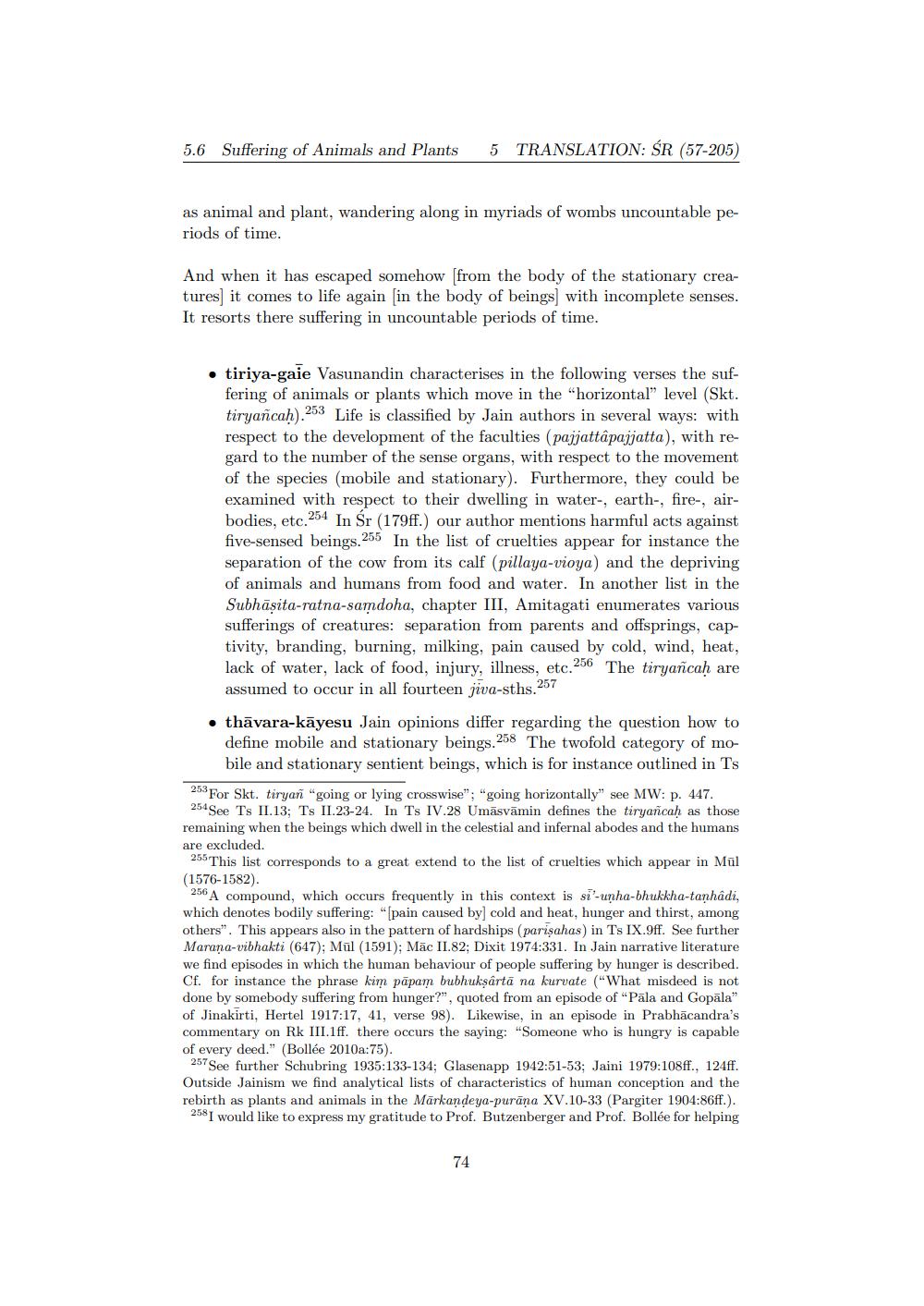________________
5.6 Suffering of Animals and Plants
5
TRANSLATION: SR (57-205)
as animal and plant, wandering along in myriads of wombs uncountable periods of time.
And when it has escaped somehow from the body of the stationary creatures) it comes to life again in the body of beings with incomplete senses. It resorts there suffering in uncountable periods of time.
• tiriya-gaie Vasunandin characterises in the following verses the suf
fering of animals or plants which move in the "horizontal" level (Skt. tiryancah).253 Life is classified by Jain authors in several ways: with respect to the development of the faculties (pajjattapajjatta), with regard to the number of the sense organs, with respect to the movement of the species (mobile and stationary). Furthermore, they could be examined with respect to their dwelling in water-, earth-, fire-, airbodies, etc.254 In Sr (179ff.) our author mentions harmful acts against five-sensed beings.255 In the list of cruelties appear for instance the separation of the cow from its calf pillaya-vioya) and the depriving of animals and humans from food and water. In another list in the Subhāṣita-ratna-samdoha, chapter III, Amitagati enumerates various sufferings of creatures: separation from parents and offsprings, captivity, branding, burning, milking, pain caused by cold, wind, heat, lack of water, lack of food, injury, illness, etc.256 The tiryañcah are assumed to occur in all fourteen jiva-sths.257
• thāvara-kāyesu Jain opinions differ regarding the question how to
define mobile and stationary beings.258 The twofold category of mobile and stationary sentient beings, which is for instance outlined in Ts
253 For Skt. tiryan "going or lying crosswise"; "going horizontally" see MW: p. 447. 254 See Ts II.13; Ts II.23-24. In Ts IV.28 Umāsvāmin defines the tiryancah as those remaining when the beings which dwell in the celestial and infernal abodes and the humans are excluded.
255 This list corresponds to a great extend to the list of cruelties which appear in Mül (1576-1582).
256 A compound, which occurs frequently in this context is si-unha-bhukkha-tanhâdi, which denotes bodily suffering: "[pain caused by] cold and heat, hunger and thirst, among others". This appears also in the pattern of hardships (parişahas) in Ts IX.9ff. See further Marana-vibhakti (647); Mül (1591); Māc II.82; Dixit 1974:331. In Jain narrative literature we find episodes in which the human behaviour of people suffering by hunger is described. Cf. for instance the phrase kim pāpam bubhuksārtā na kurvate ("What misdeed is not done by somebody suffering from hunger?", quoted from an episode of "Pāla and Gopāla" of Jinakirti, Hertel 1917:17, 41, verse 98). Likewise, in an episode in Prabhācandra's commentary on Rk III.1ff. there occurs the saying: "Someone who is hungry is capable of every deed." (Bollée 2010a:75).
257 See further Schubring 1935:133-134; Glasenapp 1942:51-53; Jaini 1979:108ff., 124ff. Outside Jainism we find analytical lists of characteristics of human conception and the rebirth as plants and animals in the Markandeya-purāna XV.10-33 (Pargiter 1904:86ff.). 258 I would like to express my gratitude to Prof. Butzenberger and Prof. Bollée for helping
74




